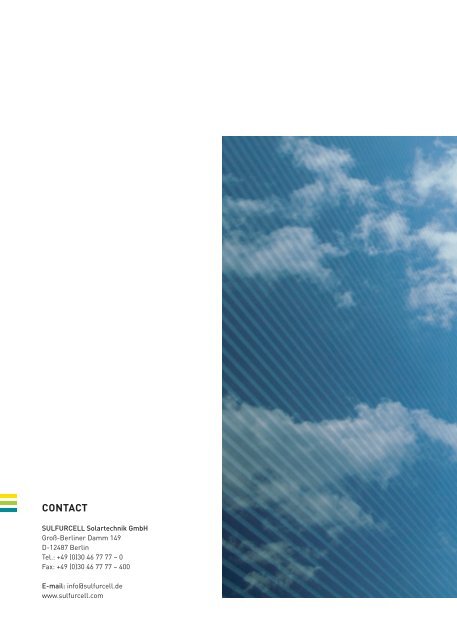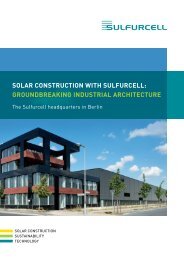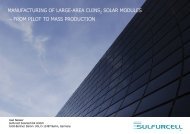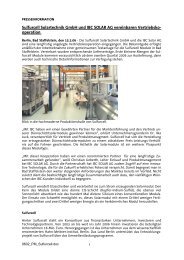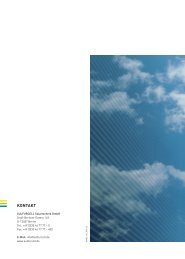ContaCt - Soltecture GmbH
ContaCt - Soltecture GmbH
ContaCt - Soltecture GmbH
You also want an ePaper? Increase the reach of your titles
YUMPU automatically turns print PDFs into web optimized ePapers that Google loves.
4 | 5 THE COMPANYSulfurcell’s management team: Dr. Axel Neisser, Martin Beck, Henrik Krüpper (CSO), Dr. Nikolaus Meyer (CEO),Dr. Rüdiger Stroh (COO), Birgit Grüner, Ulfert Rühle
Growth through innovationSULFURCELL Solartechnik <strong>GmbH</strong>Sulfurcell develops and produces high-quality thin-filmsolar modules for generating photovoltaic energy. TheBerlin company specializes in the family of materials usedfor chalcopyrite-type semiconductors, which includes copperindium sulfide and copper indium gallium selenide –“CIS semiconductors” for short. Chalcopyrite is a naturallyoccurring mineral and belongs to the sulfide class ofminerals. Sulfurcell’s power to innovate is based on thesesemiconductors – hence the name of the mineral classwas incorporated into the company name.Sulfurcell is a spin-off company from Berlin’s distinguishedHahn-Meitner Institute (now called the Helmholtz CentreBerlin for Materials and Energy), which is Europe’s largestresearch establishment for thin-film photovoltaics. Thecompany triumphed in transferring its pioneering researchactivities into industrial applications, whereby commercialmodules have been produced and sold since 2005.Sulfurcell’s customers have quickly come to ap pre ciate thenew product and its advantages. Trust has grown over theyears and Sulfurcell modules are being increasingly deployedin solar power systems and applications. In Octo ber2009, the new headquarters (3000 m 2 ) and production plant(17,000 m 2 ) were completed in which it is planned to pro -duce solar modules amounting to 35 megawatts each year.Solar modules based on CIS semiconductors provideconsiderable scope for development. In the past Sulfurcellhas constantly improved the material and has patentedits innovations. Whereas in 2005 the efficiency of thefirst solar modules was still less than 5 %, by 2008 theyhad already achieved an efficiency of 8 %. Laboratoryresults have shown that the potential is still far fromexhausted. Today, solar cells produced from CIS semiconductorsalready reach efficiency levels of 20 % underlaboratory conditions, which is more than all the othermaterials used for thin-film solar modules. Sulfurcellis therefore making major investments in developingCIS semiconductors.Sulfurcell’s team is working towards its technologicalgoals with expertise and passion. The more than fiftytechnologists at Sulfurcell include scientists with manyyears of CIS experience, engineers from the semiconductorand electronic industries as well as specialists forsolar building design. We are passionate about makingsolar energy more attractive through innovation.With its cutting edge, technically sophisticated products,Sulfurcell fully lives up to the traditional “Made inGermany” seal of quality: the company offers productsthat are distinguished by their long-term stability,attractive price/performance ratio and aesthetic excellence.The solar modules can therefore be applied asvisible building features and are already deployed likeconventional building materials. Sulfurcell has thusachieved a new dimension in building design: economic,sustainable and aesthetically excellent.Taking its lead from Mother NatureSulfurcell uses CIS semiconductorsbased on the natural mineralchalcopyrite (Photo: Lapis/Christian Weise Verlag, Munich).
6 | 7 THE COMPANYGrowththrouGh innovationHow it all beganThe seeds to Sulfurcell’s success were sewn when thecompany was founded in July 2001 by Nikolaus Meyer –now the company’s Chief Executive Officer – togetherwith colleagues from the Hahn-Meitner Institute. Thecompany’s founders seized the opportunity to apply thelatest research on thin-film technology to solar modulesin industrial production. That was the beginning of thesuccess story, which continues today.The production line commenced operations in 2004.One year later Sulfurcell presented the first prototype.Production and commercial marketing of the modulesbegan soon after in 2005. Since joining the market, theBerlin company has considerably expanded its productioncapacities. 75,000 solar modules were already sold andinstalled by the beginning of 2010. This makes Sulfurcellone the world’s three most important manufacturers ofCIS semiconductors. The company has also won severalawards for its groundbreaking research and productdevelopment – including the 2006 Innovation AwardBerlin-Brandenburg.»Sulfurcell is a promising young company with very innovative technology. Thanks tothe extensive technological know-how of its staff and the ambitious expansion plan,we can expect Sulfurcell to become a major German photovoltaic manufacturer inthe coming years. As such Sulfurcell is helping to ensure that Germany remains oneof the world leaders in photovoltaics in future, too.«Gerhard Stryi-hipp, Fraunhofer institute for Solar Energy Systems iSE, head ofEnergy Policy, Member of the Supervisory Board of Sulfurcell Solartechnik Gmbh
The Supervisory Board of SulfurcellSolartechnik <strong>GmbH</strong> (left to right)Raoul Arvengas, Gaz de France Suez, ParisGerhard Stryi-Hipp, Fraunhofer Institute for SolarEnergy Systems, FreiburgKalman Kaufman (Chairman), entrepreneur, Tel AvivDr. Stefan Beyer, Ventegis Capital, BerlinAlex Betts, Climate Change Capital, LondonHeiko von Dewitz (Observer), Intel Capital, MunichChristof Sagasser (no photo), Vattenfall Europe, BerlinFrom pilot project to mass productionThe company’s technical expertise and strong developmentas well as the growing global demand for solarmodules convinced renowned financial investors toprovide Sulfurcell with 85 million euros in July 2008 tofinance the company’s continued growth. The group ofinvestors and partners includes high-caliber stakeholdersfrom the industry itself: the Californian chip manufacturerIntel invested via Intel Capital (Santa Clara); ClimateChange Capital (London) is one of the leading investmentbanking groups investing in clean energies and lowcarbon companies; the Berliner Energie Umweltfondsis funded by Germany’s third-largest energy company,Vattenfall Europe, and the German branch of France’sleading energy group Gaz de France Suez; VentegisCapital (Berlin), Demeter (Paris), Zouk (London), AIG(Zürich), Bankinvest (Copenhagen), Engelbert Giesen(Berlin) and Masdar Clean Tech Fund (Abu Dhabi) allinvested as well.The staff – the most important capitalOur company’s success is essentially due to our 200members of staff (as of May 2010). Highly qualifiedtechnolo gists, technicians and production staff ensurethat Sulfurcell and its products continuously develop.A lean administration and sales team ensure that everythingruns smoothly and supports our partners andcustomers with competent advice and assistance.What motivates them all is a passion for pioneeringsolar solutions. An enthusiasm for technology and goodteamwork unite them. Together they help shape thefuture of Sulfurcell. That is a good basis for more growthin the coming years. To facilitate this growth, Sulfurcellis planning to double the number of employees, by hiringadditional engineers and scientists in particular. This isbecause Sulfurcell will need highly qualified colleaguesto maintain its ability to innovate and grow in future.The fresh capital has been spent on constructing a newproduction plant in Berlin-Adlershof and on research. Thenew factory will increase Sulfurcell’s production capacityto 35 megawatts (MW) initially. The second phase will seecapacity rise to 75 MW. The leap to mass production hasbeen achieved.
8 | 9 THE COMPANYChaLLEnGES and GoaLSPhaSE 2: 2005-2009INDUSTRIALIZATIONPhaSE 1: 2003-2005UPSCALINGProduction volume1.8 MW2.4 MW2003Laboratory module from theHahn-Meitner Institute (5 cm x 5 cm)0.5 MW50 kW0.2 MW2005 2006 2007 2008 2009Average efficiencyAperture surface: 1.20 m x 0.60 m5.8%7.2%7.4%7.7% 8.1%2005 2006 2007 2008 20092005First solar module from Sulfurcell(125 cm x 65 cm)YieldModule output / Glass input79% 82%22%40%50%2005 2006 2007 2008 2009Cycle time for CIS productionTime between two coating processes75 min15 min 10 min 5 min 5 min2005 2006 2007 2008 2009SuStainaBiLity in aCtionSulfurcell’s new production centerSulfurcell also bases its corporate decision-making onsustainability factors. Correspondingly, the companywas one of the first signatories of the “Berlin ClimateAlliance” at the end of 2008. Together with the city ofBerlin and twelve other renowned firms, Sulfurcell isactively committed to reducing CO 2 emissions in Berlin:the aim is a decrease of more than 40% from 1990 to2020. This is because for the staff and management,climate protection goes hand in hand with corporateresponsibility. They have contributed by expandingSulfurcell’s production capacities in Berlin-Adlershof.The annual production rate there is being increased to35 megawatts. After all, every kilowatt-hour of electricitygenerated in a photovoltaic installation is a step in theright direction. This is why solar modules were also usedfor the new administration building and production plant.Large-scale solar power systems supply the new buildingwith energy. 700 modules on the facade and a 300 kWroof-mounted system will provide renewable energy forthe production operation. The administration building is100% energy self-sufficient.
PhaSE 3: FroM 2008COST REDUCTION AND GRID PARITYMass productionContinual improvement of technologyAverage efficiency of sold modules14%12%ProduCt LinE 210%8%6%ProduCt LinE 14%2005 2007 2009 2011e 2013e✔75 MW expansion launched✔ 2008 Development projects defined,financed and launchedSulfurcell’s headquarters
10 | 11 SYSTEM SOLUTIONSSolar construction: Roof integrationSulfurcell sets trends for building the futureWhether for residential buildings, public buildings orcommercial properties: the desire to combine renewableenergy generation, energy-efficient construction andattractive architecture is becoming increasingly important.Sulfurcell manages to unite all these elements inits own unique way: by means of solar modules whichcan be integrated into facades and roofs. Therein liesthe future of construction. That is solar construction.Fitters, trade professionals and architects value theanthracite-colored Sulfurcell modules with the finepinstripes. Thanks to their compact form, they can bemade to fit all sorts of building surfaces perfectly, andthe solar modules give roofs the same harmoniousstructure as conventional roof tiles. This is what setsSulfurcell modules apart – not just from crystalline siliconmodules, which are undesirable for solar constructionbecause of their chess board-like appearance, but alsofrom other thin-film modules which are mostly unevenand brownish or purple. Sulfurcell guarantees excellentquality and offers solar modules with an even darksurface. Many of our partners describe our modules asthe most attractive solar modules on the market.Sulfurcell’s solar modules are ideal for large agriculturalor industrial buildings. They blend in with the naturallandscape and enhance the roof – not just visually butalso economically, for having a solar power system onSulfurcell modules blend in with the natural landscape – including on agricultural buildings
the roof makes use of surface areas that would otherwiselie idle. If, on the other hand, they are covered in modules,they can make money – all the more if the roof is optimallyangled to the sun, the installation is as simple as possibleand the costs of the solar modules themselves are kept toa minimum. Hence, the advantages of Sulfurcell modulesare very clear – for they are easy to install and offer excel -lent value for money. The special system solutions ofSulfurcell’s specialized dealers are partly responsible forthis. Customers benefit from the solar system’s extremelyhigh profitability and enjoy a module technology that isenvironmentally friendly, innovative and high-quality.Sulfurcell’s roof-integrated modules replace roof tilesand protect the house from weathering. They also coverthe house’s energy requirements and give the buildingan attractive modern appearance.
12 | 13 SYSTEM SOLUTIONSSolar facade on a building belonging to the Rückgrat companyin Donaueschingen, Germany (architect: Günter Limberger)Solar construction: Facade integrationSolar construction means using solar modules likeconventional building materials and replacing passiveconstruction materials. The modules thus fulfill twofunctions – providing the building shell and generatingenergy. Furthermore, the solar application is even moreeconomical as it saves on the costs for tiles or facadepanels. Sulfurcell’s product range offers ideal constructionelements for every part of a building. The productionhall of the company Heuchemer in Miehlen (Taunus)is just one example of a facade-integrated PV array.Sulfurcell modules adorn the facade of this building,replacing passive construction materials. Moreover,Sulfurcell is applying a similar solution to its new companyheadquarters (see image on p. 9). Conventionalmounting systems can be used as well and, in conjunctionwith Sulfurcell modules, achieve a more elegant appearance.The building illustrated on this page demonstratesthe use of Sulfurcell’s frameless modules, which havebeen installed on the AluTec mount ing system fromCreoTecc. This turns the solar module into an architecturalhighlight and en hances the building, something thatis usually only pos si ble with expensive special glass ornatural stone panels.
Facade-integrated modules on an industrial building belonging tothe Heuchemer company in Miehlen, Germany (design: Goldbeck Bau)Facade cladding with solar modules providing solar controlon a building belonging to the Max Fuss company in BerlinThe solar facade of the Ferdinand BraunInstitute for High Frequency Technologyin BerlinSulfurcell has set new standards in solar architecturewith the solar facade of the Ferdinand Braun Institute forHigh Frequency Technology (FBH) in Berlin. Sulfurcellaccompanied the project from the planning to the installationas a competent partner. The shiny black wall isabout 640 square meters in size (8 by 80 meters) and hasa peak capacity of about 39 kilowatts. Dresden-basedarchitect Christian Matzke designed the elegant, curvedsolar wall as part of extensive new construction and conversionmeasures to the FBH. The facade was installed byDachland <strong>GmbH</strong>. With this impressive facade, Sulfurcelldemonstrates what is possible in solar architecture.
14 | 15 TECHNOLOGYPhotovoltaics of the futureSulfurcell produces thin-film solar modulesbased on semiconductors from the CIS familyIn recent years the number of photovoltaic absorbermaterials has grown and grown. The conventional crystallinesilicon modules have been joined by thin-film solarmodules, which bring benefits for many applications.The thin-film technologies include solar modules madeof CIS semiconductors, like the ones Sulfurcell has beenproducing for years. The Berlin company helped toresearch and develop this groundbreaking photovoltaictechnology and patented it.Thin-film technology based on CIS semiconductors differsfrom other solar modules in that it is environmentallyfriendly from the very outset, i.e., no high-temperatureprocesses have to be applied in production, so the energyconsumption is low and is recaptured during the firstoperating year via the sunlight used. Toxic process gasesand chlorine chemicals are spared. But most important ofall, the production of the modules uses natural resourcessparingly: the glass is coated with a razor-thin layer ofsemiconducting material which converts sunlight intoelectricity. It is thinner than a hair, and a hundred timesthinner than the silicon wafers used for conventionalmodules. The few concerns that the element indium, as ispresent in CIS semiconductors, was too scarce to be usedfor mass production have been scientifically refuted. 1)Indium exists in sufficient quantities in the Earth’s crustand is even found more often than silver.Sulfurcell is working hard to enhance its technologicaledge. To this end, it collaborates with leading researchinstitutes such as the Helmholtz-Zentrum Berlin andthe University of Oldenburg. Under laboratory conditionsCIS semiconductors already reach the highest degree ofefficiency of all the materials used for thin-film modules.CIS technology, a competitive comparisonSemiconductor materialPolycrystallinesilicon moduleModules (wafers)Polycrystalline siliconCIS modulefrom SulfurcellThin-filmCISCuInS 2 , Cu(In,Ga)Se 2 ,Cu(In,Ga)(S,Se) 2Cadmium tellurideCdTe1)See “Indium: Geology, Mineralogy, and Economics”by Ulrich Schwarz-Schampera and Peter M. Herzig,Springer, Berlin (2002).2)Solar efficiency tables, Progress in Photovoltaics,Vol. 15, 425-430 (2007)Amorphous/microcrystalline silicona-Si/µ-Si
»Sulfurcell is the most important industrial partner for the Helmholtz Centre Berlinin the field of CIS solar cells. Its team managed to develop a reliable and attractivephotovoltaic product based on entrepreneurial vision and scientific expertise.The company’s technology roadmap is very convincing and will enable the company«to continuously increase the efficiency of its thin-film solar modules.Professor hans-werner Schock, helmholtz Centre Berlin for Materials and EnergyThe aim is to exploit this potential on an industrial scale.Thanks to the material’s modification possibilities, themodule capacity can be constantly improved: the elements– indium, gallium, sulfur and selenium – can becombined with each other in various ways. In addition,alternative manufacturing processes open up a wholerange of options with which our technologists can workinnovatively. It is these optimization possibilities that willmake it possible for CIS semiconductors to achieve thesame efficiency as today’s polycrystalline silicon solarmodules in the long term. And at the same time they haveconsiderable cost benefits compared to polycrystallinesilicon solar modules: the amount of expensive semiconductormaterial required in production sinks dramatically –instead of 500 grams of silicon per square meter, just fivegrams of CIS are used. CIS semiconductors also avoid themulti-layer production process required for conventionalmodules and cut two thirds of the production steps.Maximum efficiency(Lab records 2 )20.3%Advantages— Solution when space available is limitedbut high capacity is requiredDisadvantages— Higher costs and energy consumptionin production— Not attractive for solar construction— Power loss with high operatingtemperatures19.5%— High efficiency and potentialto reduce costs— Environmentally friendly technology— Most attractive appearance,ideal for solar construction— Production volume still low16.5% — Low production costs— Low acceptance for applicationin or on buildings11.7%— High availability thanks tolarge production volumes— Can also be used in watchesand calculators— Low efficiency potential— Energy yield falls in the firstoperating years— Module format and electricaldesign often awkward
16 | 17 TECHNOLOGYGenerating electricity from glassThe production of Sulfurcell modulesOn the surface the production of CIS solar modules issimple, yet it is technologically complex. The sourcematerial for Sulfurcell solar modules is simple windowglass. The glass is coated with thin layers of metals andsemiconductors, which make up the CIS solar cells.In order to apply these layers to the glass, a processcalled sputtering is used. This process has been usedsuccessfully for decades for coating large-scale architecturalglass, and it is known for its high energy efficiency.Today virtually all panes in industrial construction gothrough a sputter system at least once in order to belayered with sun or heat protection. Sulfurcell has putthe experience gained by the glass industry to good use:it uses sputtering to coat the glass, which makes themodule coating extremely even. This is the basis of thehomogenous design, and it is what makes the subsequentproducts so attractive.To produce the centerpiece of the solar module, the CISsemiconductor, several elements have to be combined.Sulfurcell does this by exposing sputtered layers ofcopper, indium and gallium to sulfur or selenium vaporand heating them to 500 degrees Celsius. The Sulfurcellengineers set great store by developing a quick – andthus productive and energy-conserving – process forthis. In 2006 the panels had to be heated for more than15 minutes, but today this has been reduced to just twominutes – an achievement unparalleled by competitors.In the case of solar modules the glass has to be morethan just ‘stained’ – after all, the layers have to performan electric function. That’s where the real challenge ofproducing CIS solar module lies. The layers applied maynot be contaminated. They have to stick to each otherand be combined electrically – and their properties haveto be kept constant from glass pane to glass pane, weekto week. Thus, before the commencement of mass pro -duction in 2008 the company carried out pilot productionoperations for three years, all the while optimizing allprocesses and workflows. When it came to the selectionof the technology, initially a simple CIS process waschosen that used only copper, indium and sulfur. With thisbasic process the company quickly managed to achievegood efficiency levels and stable production. As a result,at the end of 2005, Sulfurcell was one of the first providersto launch CIS solar modules onto the market. Sulfurcellwill now continue to develop itself technologically bybuilding on its tried-and-tested basic production technologyand by implementing even more complex processes.It already has the scientifically verified formulas for highefficiency – and with its valuable production experience,Sulfurcell will be able to apply them successfully tofuture production.Plasma during the sputter coating of glassA glimpse of Sulfurcell’s mass production
Solar modules from Sulfurcell: Method of functioning and quality featuresThe hardened, smooth-edged front glass(5 mm) protects the solar module from hailimpact, wind and snow loads.laminate film (EVA)supply cable82 stripy solar cellsconnected to eachother make up thesolar module.The back side glass (2 mm)contains the active solarcell layers.CIS layer (0.004 mm)molybdenumHigh-grade sealing seals theglass-glass laminates and protectsfrom humidity and corrosion.sunlightZinc oxide front contact0.004 mmCIS absorbermolybdenum back contactIn the CIS absorbersunlight is convertedinto electricity.back side glass (2 mm)
18 | 19 SULFURCELL MODULESEConoMiC, SuStainaBLE, aESthEtiC• Qualified, IEC EN 61646• Safety tested,IEC EN 61730• Periodic InspectionQuality: highest standards guaranteedSulfurcell sets itself high standards. Quality begins inproduction, which we organize according to ISO standard9000/9001, and continues right through to the final product.Customers of Sulfurcell enjoy products that last. In orderto guarantee this longevity, the solar modules are testedexternally and internally regularly. And they pass thesetests with flying colors: the prestigious TÜV Rheinland(Rhineland Technical Inspection Agency) has certified allthree Sulfurcell solar modules according to the qualitystandards IEC EN 61646 and IEC EN 61730.Our products are also continuously tested in our ownlaboratory – where they undergo accelerated life-timetests. During these tests they are subjected to high levelsof humidity and extreme temperature fluctuations.The tests also simulate the strain of strong winds, largequantities of snow and hailstorms. We also check thelong-term resistance of our modules to UV radiation andtest each module for its high-voltage stability. The powerof each individual module is precisely measured usingclass A sun simulators and these results are made availableto the customer.But Sulfurcell’s solar modules don’t just pass the testsunder laboratory conditions, they also prevail in real-lifelongevity tests. The data from the test equipment provideimportant information on how to maximize the energyyields during the permanent operations and make itpossible to measure the actual energy yields of a solarapplication. The endurance tests have proven whatModule power after accelerated ageing(1 000 hrs, 85°C, 85% rel. humidity)Sulfurcell’s climate chamber for accelerated module ageing100%80%Av. value: 97%60%40%20%0%01.01.2006 01.01.2007 01.01.200801.01.2009Accelerated life-time tests simulate the performance of the modulesafter twenty years. Sulfurcell’s modules still achieve 97 % of theiroriginal capacity in the damp-heat test, more than the 95 % requiredby the TÜV. The graphic shows test results from modules from threeproduction years.
the physics tell us: that CIS semiconductors solarmodules do not lose 10 to 20 % of their capacity in thefirst operating year, like thin-film amorphous siliconsolar modules. Rather, the yield properties of theSulfurcell solar modules are much more similar toconventional polycrystalline silicon modules – yet theyare markedly superior in warm, sunny countries.Sulfurcell also demonstrates how the capacity of aphoto voltaic installation can be maximized with the choiceof the right system components. Thus in its installationguide, Sulfurcell provides information on how a solar powersystem should be electrically installed. This ensuresthat the inverters and assembly system are matchedto our modules.Installation: quick and painlessSulfurcell modules are just 0.8 square meters in size,which means a good roof coverage is possible and thedistances to dormer windows and ridges can be kept low.The fitters appreciate the light weight and the formatof the modules and can transport and assemble themwithout any elaborate tools. The modules can be assembledboth horizontally and vertically, have long connectingcables and plugs that comply with established internationalstandards. Their low VOC and the high admissiblesystem voltage make long strings possible and reduce theamount of wiring required. In short, they give the fitterthe flexibility needed to meet the specific needs of eachindividual project.Sulfurcell’s bending test for frameless modulesMicroscopic quality inspectionduring production
20 | 21 SULFURCELL MODULESTechnical backgroundEfficiency, energy yieldand profitabilityThe efficiency of a solar module reveals what proportionof the sunlight is converted into electrical power and whatelectrical power can be gained from a certain surfacearea. Solar modules are priced according to their output(measured in watts [W]). With regard to their efficiency,solar power systems only differ from one other in termsof the surface area that a solar installation with a certainoutput covers. Modules with a lower efficiency are usuallycheaper per watt than those with a higher efficiency.Hence, if there is enough space or if the investment sumhas to be kept low, low-cost solar modules with a lowefficiency should be used. However, if space is limitedand the output has to be maximized, a higher efficiencyis required and the price per watt will be higher too. Thus,higher efficiency often means lower profitability and agreater investment, but is more compact. So the efficiencylevel is just one of many quality criteria, but does notindicate the price/performance ratio.In 2008 Sulfurcell sold solar modules which had anefficiency of up to 7.5%, and higher efficiency rates areexpected in 2009 and 2010. The space needed for aSulfurcell installation is about two thirds more than for atypical polycrystalline silicon solar module. But Sulfurcell’scustomers know that Sulfurcell makes modules that aremuch more cost-effective than crystalline silicon productsof a comparable quality per watt of electrical output.In terms of the surface area of a roof, the savings factoris even greater: in this regard the Sulfurcell installationis up to 50% more cost-effective than an installation withsilicon modules. So if a roof is to be completely coveredwith solar modules, Sulfurcell modules lower the investmentand the loans required considerably.The annual energy yield – measured in kilowatt-hours peryear (kWh/a) – is not determined solely by the efficiency,for this depends on the illumination conditions and thee Sulfurcell’s solar modules are more “tolerant” of heatthan crystalline silicon modules and are therefore particularlysuitable for southern latitudes.r The monthly appraisal of the energy yields provesthe consistent performance of Sulfurcell modules andtheir strong performance in warm summer months.e1.2 kW1.1 kW1 kWActual output of 1 kWp solar power systems(with perpendicular sunlight, AM 1.5, 1 000 W/m 2 )t The energy yield from Sulfurcell’s modules is just asstable and as high as for polycrystalline silicon modules.In contrast to amorphous silicon, the capacity of Sulfurcellmodules does not decrease in the second operating year.u The warmer the place, the greater the benefits ofSulfurcell modules. In Greece, a 5% greater yield has beenmeasured compared to crystalline silicon modules.0.9 kW0.8 kW0.7 kW0.6 kWPolycrystalline siliconSulfurcell modules0°C 10°C 20°C 30°C 40°C 50°C 60°C 70°C 80°CModule operating temperature
operating temperature of the solar modules as well.The solar industry has therefore defined standard testconditions in which the efficiency is determined. Themanufacturers also derive the rated power of a solarmodule (measured in watt-peak [Wp]) as indicated onthe data sheets from these laboratory tests and base themodule price on it. Standard test conditions, for example25°C operating temperature and midsummer-strength(1000 W/m 2 ) perpendicular sunlight, occur rarely inreal-life operations and are, at best, conceivable on coldsummer days. In summer solar modules typically workat temperatures of 50 to 80°C and the efficiency falls. Thetemperature coefficient refers to the fall in capacity perdegree Celsius. This is another strength of the Sulfurcellsolar modules: their good temperature coefficient makesthem ideal for warmer regions (e. g. in southern Europe)and manifests itself in a higher energy yield per watt-peak.Thus, depending on where they are installed, Sulfurcellsolar modules can achieve annual yields that are 4 to 8per cent higher than that of crystalline silicon modules.Last but not least, the annual energy yields per watt-peakdepend on the system technology and the solar radiation.Maximum yields can be reached when the best possibleinstallation locations and angles are found, the rightinverters are fitted to the modules, and the installation isconnected and installed professionally. Sulfurcell workstogether with reputable dealers who have this expertiseand have installed thousands of applications. They provideon-site advice and help the user to get the most out ofSulfurcell’s modules.r1601401201008060Annual energy yield of 1 kW solar power systemsBerlin (roof-mounted)t1100950800650500uAnnual energy yield1 kW solar power systemsBerlin (roof-mounted)CISPoly-SiAmorphous-SiCISPoly-SiAmorphous-SiCISPoly-SiAmorphous-Si2007 2008 2009Annual energy yield 20081 kW solar power systemsBerlin/Trikala105%101% 100% 100%40200Jan 07Feb 07Mar 07Apr 07May 07June 07July 07Aug 07Sep 07Oct 07Nov 07Dec 07Jan 08Feb 08Mar 08Apr 08May 08June 08July 08Aug 08Sep 08Oct 08Nov 08Dec 08Jan 09Feb 09Mar 09Apr 09May 09June 09July 09Aug 09Sep 09Oct 09Nov 09Dec 09CISPoly-SiCISPoly-SiCIS modules from SulfurcellPolycrystalline silicon modulesGermanyGreece
22 | 23 SULFURCELL MODULESModels and application possibilitiesWith a virtually black main surface area and light conducting paths, the Sulfurcell modules can be described as“anthracite with pinstripes” and are among the most visually attractive solar modules on the market. This makes themparticularly suitable for integrating into roofs or facades. Sulfurcell designs its solar modules in such a way that theycan be easily used as building materials. Countless projects are the definitive proof that Sulfurcell is a preferred partnerfor architects and building contractors and can fulfill the highest design and structural engineering requirements.Laminate module type SCG-HV-LThe laminate modules are furnished with a hardened,5 mm-thick front glass and therefore, even withouta frame, offer the high mechanical stability required bythe TÜV (German Technical Inspection Agency) for solarmodules. The modules are the best option for large agri -cultural or industrial roofs. But construction engineersand planners also appreciate the laminate modulesbecause they can be easily integrated into standardbuildings and glass constructions. They are also idealfor roofs with a low tilt angle (of up to two degrees),since water and dirt can run off easily.Cardboard sleeves protect Sulfurcell’s laminatemodules during transport and installationSulfurcell has optimised the costs for this model. It hasbeen possible to dispense with the expensive aluminiumframe since Sulfurcell modules are smaller than conventionalsilicon modules. This way they have a far higherinherent stability and can withstand pressures and strainsin the long term. Aluminum is only necessary for the solarinstallation’s substructure, which reduces the consumptionof this energy-intensive material by 30 %. The laminatemodule manages to combine an extremely impressivemaximum profitability with the conservation of resources.Sulfurcell’s laminate modules boast another advantagetoo: Sulfurcell supplies its laminate modules in card -board sleeves. They protect the module during installationand function as a buffer in case the module is struck.The cardboard sleeves are not removed until after theinstallation process is complete – so Sulfurcell combinesthe benefits of frameless modules with simple and safeinstallation.
Framed module type SCG-HV-FWhether as a facade element or on the roof –our framed module is always suitable.Thanks to the aluminum frame and hardenedfront panel, they are so robust they can evenbe used in areas with heavy snowfall (snowload zone 3). The modules are particularlysimple to install since the frame protects theglass from being damaged. This means theycan be installed in places that are difficultto access or on mounts, which wouldn’t bepossible with frameless modules.Ecology: green technologySulfurcell sees itself as a pioneer in the fight againstclimate change. That means our manufacturing processeshave to meet the highest ecological standards as well.And they do so demonstrably: with thin-film technologya comparably small amount of resource material is usedand little energy is consumed in production. Thanks tothe high yields of CIS technology, there is also a dynamicamortization period of one year – half the amortizationperiod for crystalline silicon modules.Sulfurcell solar modules are environmentally friendly andcan be disposed of as household rubbish at the end of theirlife cycle according to the current statutory regulations.Nevertheless, Sulfurcell has developed a return systemfor solar modules so that the recyclable materials –especially glass and aluminum – are reintegrated intothe cycle of materials. As such Sulfurcell is a foundingmember of the PV Cycle Association, which is developinga return and recycling program for the solar industry.www.pvcycle.org
24 | 25 SULFURCELL MODULESSoLar rooF tiLESRoof-integrated modules are mountedlike shingles using the same principleused for installing roof tilesRoof-integrated module type SCG-HV-RIThe roof-integrated module offers new possibilities insolar construction. The modules are installed quickly andeasily on the roof battens like tiles, thus saving on tilecosts. The use of these modules saves construction costsof about 20 – 30 €/m 2 . The use of black SOLRIF frames,tried and tested in the industry and made by the companySchweizer Metallbau, makes them easier to install,gives the roof a homogenous and aesthetically pleasingappearance and offers excellent design possibilities.But most important of all, the installation is simpler thanwith other roof integration solutions: French specialistsfrom the consultancy firm Cythelia compared variousroof-integrated solar systems in 2008 as part of anextensive market study. Their investigations revealedSolrif-based solutions as the test winner.Sulfurcell’s system partners assist the user with thelayout or roof finish of the solar installation. Custom-fitsheets provide a perfect roof finish so that patchworksolutions can be avoided.
SoLar FaCadE CaSSEttESThe rear ventilation preventsinterstitial condensation andcools the solar modulesIn industrial construction it is common to use facadecassettes because they provide weather-proof coverfor insulation and discharge rainwater in a controlledmanner. They are made of sheet metal and are mountedonto the facade. Sulfurcell has developed a technologyfor giving these facade cassettes a further advantageand enhancing them visually, too. Sulfurcell offerscassettes that contain a laminate module on the surface.In contrast to other facade-integrated solar systems,this way frameless modules can be used for the facade.This converts the sheet metal facade into an elegant glassfacade which also generates electricity for the officesbehind. This new technology is being applied for the firsttime to Sulfurcell’s new company building in Berlin, whereit can also be viewed.
26 | 27 SULFURCELL MODULESWEIGHT-OPTIMIZED SOLAR POWER SYSTEMSFOR COMMERCIAL FLAT ROOFSWind protectionBallastFoilStructure of a commercial factory roofwith a superimposed solar power systemIt is often not possible to install conventional solar powersystems on large-scale flat roofs because the solar powersystems weigh too much or there are no suitable meansfor fixing them. Sulfurcell’s flat roof solution offers anintelligent response: the system is weight- and wind loadoptimizedand only has a load of 19 kg per m 2 (plus ballast).The particularly low-profile installation reduces the surfaceexposed to wind, while additional wind protection panelsreduce the suction even more, enabling the solar powersystem to be mounted without the need for fixings thatpenetrate the roof. The low-profile installation also mini -mizes shading from the modules, enabling the modulerows to be placed closely together. This thus enables aminimum output of 55 kW to be installed per 1000 m 2 ofsurface area.


